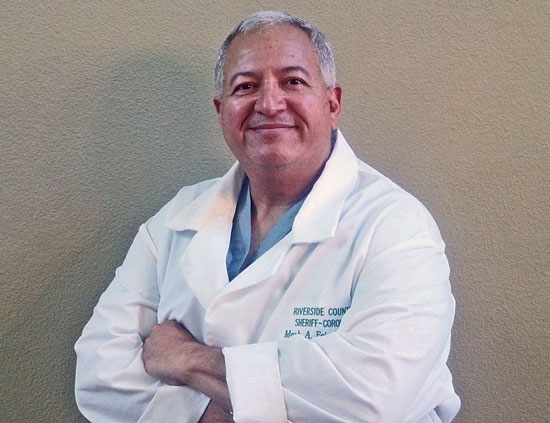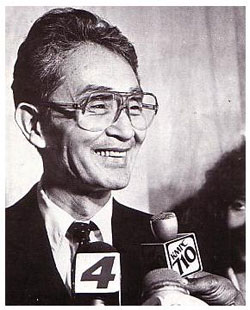Meet our new “coroner to the stars”
July 9, 2013

Highly skilled with a scalpel, L.A.'s new coroner will now have to become facile with the celebrity-struck media.
Dr. Mark Fajardo has done thousands of autopsies in the dozen or so years he has spent as a forensic pathologist with Riverside County. From Palm Springs retirees to meth addicts to the renegade former Los Angeles Police Officer Christopher Dorner, he has examined all walks of toe-tagged life.
Still, as the Board of Supervisors named him Los Angeles County’s new chief medical examiner-coroner on Tuesday, Fajardo acknowledged that L.A. has one kind of death to which he’ll have to become accustomed when he steps into the job in August.
“In Riverside County,” he says, laughing, “we run the gamut—except for the celebrities.”
Fajardo, 49, succeeds Dr. Lakshmanan Sathyavagiswaran, who will retire this year after more than 21 years in the position that has come to be viewed as perhaps the nation’s most public coroner’s job.
Marilyn Monroe’s death was investigated by the Los Angeles County Department of Coroner; so were Sen. Robert F. Kennedy’s and Sharon Tate’s and Janis Joplin’s and John Belushi’s and Notorious B.I.G.’s and Michael Jackson’s and Whitney Houston’s and the paparazzo who died earlier this year trying to get a photo of Justin Bieber.
So many high profile cases come through the department, in fact, that in some instances, they’ve boosted the coroner himself to star status. Between 1967 and 1982, Dr. Thomas T. Noguchi came to be known as the “coroner to the stars.”
“I haven’t had to interact with the press much at all, so this will be interesting,” says Fajardo, noting that he hopes to follow Sathyavagiswaran’s lead and delegate most of the media interaction to someone else in the department. Despite a nationally televised stint on the stand during the trial of O.J. Simpson, the current coroner came to be known less for his time in the spotlight than for his competence in rebuilding the department after Noguchi and his successor, Ronald Kornblum, left their jobs amid management lapses and critical audits.
Nonetheless, Fajardo says, when he visited the department, he and Sathyavagiswaran talked at length about the challenges of dealing with death, L.A.-style.
“He told me that you lose all privacy, that you might have any member of the press asking any question at any time, and that you have to be prepared to answer openly,” says Fajardo. “And we talked about the media’s involvement in the case of Michael Jackson. He said there was such a caravan of cameras and paparazzi that they had to utilize a helicopter just to get him from Point A to Point B.”
That said, Fajardo says he’s looking forward to the $275,000-a-year job, which brings him and his wife, a San Bernardino County employee, back to his hometown.
Born at LAC+USC Medical Center, he spent his childhood in East Los Angeles and Pico Rivera. When he was 12, his father, a Los Angeles County deputy sheriff, was killed in an automobile accident on the way to work, and the family moved to be near relatives in Santa Maria.
It was there, while Fajardo was in high school, that the door to his current career opened.
“I took a class at a local community college to learn how to be an EMT,” he recalls.
That skill helped pay his way through his undergraduate training and medical school at UC Davis, where he initially aspired to be an emergency room doctor.
“I actually ran the student clinic at UC Davis,” he remembers. “But the people I played basketball with were pathologists and the friendships I made led me down that path instead.”
At Riverside County, he says, he has performed more than 5,500 autopsies, including more than 350 homicide cases while managing seven full- and part-time pathologists and helping manage a department that handles some 11,000 cases a year.
“This is as far removed as you can get from what most people think of as working as a doctor,” says Fajardo. “But for me, every case is a puzzle I get to solve, hopefully in a way that gives their families closure. I speak for the dead. I try to answer the questions about how they lost their lives.”
Demographically, he says, his caseload isn’t much different than Los Angeles County’s.
“We have our share of homicides,” he says ruefully. “And we’ve had six officer-involved shootings in the last month.”
But while the Riverside County coroner’s operation is large by some measures, serving about 1.3 million people, its constituency is only a fraction of the size of L.A. County’s.
“To me, that’s probably the biggest challenge,” says Fajardo. “Ten million people and all of them have needs. And we have to meet them—we provide a service, just like sheriff’s deputies and firefighters. It’s just that, unless a celebrity dies, people just don’t notice us as much.”
Posted 7/9/13













 405 bridge work causes a stink
405 bridge work causes a stink
